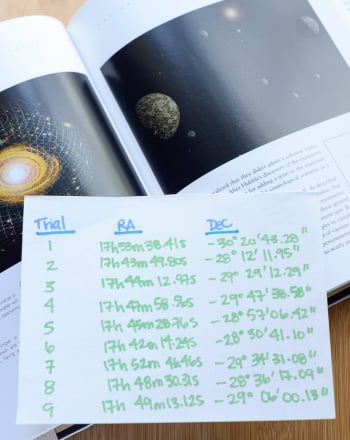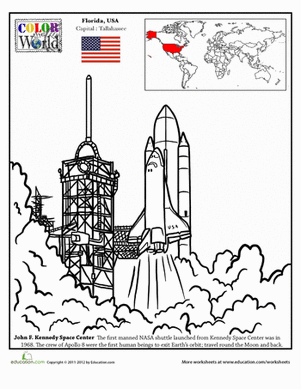Activity
Locating the Center of the Universe Using Globular Clusters
Abstract
- Purpose
- The purpose of this experiment is to find the galactic center of the Milky Way Galaxy using globular clusters.
- Procedure
- List all known globular clusters in the Milky Way.
- Choose three constellations that consist of the most globular clusters.
- Open Google Earth and go to “Sky View”.
- Type in the name of the three constellations.
- Zoom out until all three are in view.
- Download Stars and Globular Cluster app in Google Earth.
- Unclick “Stars” and click “Globular Cluster”.
- Click “Orbit”.
- Observe the orbits of the globular clusters.
- Predict where the galactic center is based on the rotations of each globular cluster.
- Record Right Ascension and Declination.
- Repeat eight more times to ensure accuracy.
- Conclusion
- In conclusion, the purpose of this experiment was to locate the Galactic Center using globular clusters. My hypothesis stated that by implementing the orbits of a globular cluster, one could predict where the Galactic Center lies. The experiment completed was very accurate in astronomical terms. All results came within range of the Galactic Center’s actual coordinates.
Type
Physical Science
Grade
11th Grade
Difficulty of the Project
Cost
Approximately $15
Safety Issues
There was no safety issues associated with this project.
Time Taken to Complete the Project
Three months
Objective
The project was to locate the Galactic Center of the Milky Way Galaxy using the orbits of Globular Clusters.
Materials and Equipment
Materials used in this experiment are as follows:
- Notebook
- Google Earth
- The notebook used was a house hold item. Google earth was downloaded from the internet.
Introduction
The purpose of this experiment is to find the galactic center of the Milky Way Galaxy using globular clusters.
The hypothesis of the experiment states that if you could locate globular clusters orbiting the galactic center, one could hypothesize the location of the center.
Scientists and researchers have always experimented trying to accurately pinpoint locations in space. By incorporating the orbits and velocities of globular clusters, one could hypothesize the location of the Milky Way’s galactic center.
Terms and Concepts for Background Research
- Galaxy – any of the very large groups of stars and associated matter that are found throughout the universe; matter in space
- Constellation – the configuration of stars especially at one's birth
- Right Ascension – measure of an angle that increases towards the east; recorded in hours, minutes, and seconds
- Declination – measured in degrees north or south of the celestial equator; recorded in degrees, minute, and seconds of arc
- Globular Cluster – extremely tight, spherical groups of old stars
Research Questions
Determining the velocities of Globular Clusters around the Galactic Center.
Experimental Procedure
Experimental procedure is as follows:
- List all known globular clusters in the Milky Way.
- Choose three constellations that consist of the most globular clusters.
- Open Google Earth and go to “Sky View”.
- Type in the name of the three constellations.
- Zoom out until all three are in view.
- Download Stars and Globular Cluster app in Google Earth.
- Unclick “Stars” and click “Globular Cluster”.
- Click “Orbit”.
- Observe the orbits of the globular clusters.
- Predict where the galactic center is based on the rotations of each globular cluster.
- Record Right Ascension and Declination.
- Repeat eight more times to ensure accuracy.
Results
The results of this experiment have shown to be very accurate in astronomical aspects. Most predictions of where the galactic center lay were very close to the actual coordinates. RA and Dec. are used within the results. For those who are not familiar with the meanings, RA is Right Ascension, and Dec. means Declination. Right Ascension is similar to longitude. They both measure an angle that increases towards the east. It is most commonly measured in measured in hours, minutes, and seconds. Declination is similar to latitude. It is measured in degrees north or south of the celestial equator.
Declination is often measured in degrees, minute, and seconds of arc.
|
Trial
|
RA
|
Dec
|
|
1
|
17h33m38.41s
|
-30°20'43.28"
|
|
2
|
17h43m49.80s
|
-28°12'11.95"
|
|
3
|
17h44m12.97s
|
-29°29'12.29"
|
|
4
|
17h47m58.56s
|
-29°47'38.58"
|
|
5
|
17h45m28.76s
|
-28°57'06.42"
|
|
6
|
17h42m14.24s
|
-28°30'41.10"
|
|
7
|
17h52m46.46s
|
-29°34'31.08"
|
|
8
|
17h48m30.31s
|
-28°36'17.09"
|
|
9
|
17h49m13.12s
|
-29°06'00.13"
|
|
Actual Coordinates
|
|
|
RA
|
Dec
|
|
17h45m39.96s
|
29°00'28.10"
|
|
|
Hours
|
Minutes
|
Seconds
|
Total Seconds
|
|
RA 1
|
17
|
33
|
38.41
|
63218.41
|
|
RA 2
|
17
|
43
|
49.8
|
63829.8
|
|
RA 3
|
17
|
44
|
12.97
|
63852.97
|
|
RA 4
|
17
|
47
|
58.56
|
64078.56
|
|
RA 5
|
17
|
45
|
28.76
|
63928.76
|
|
RA 6
|
17
|
42
|
14.24
|
63734.24
|
|
RA 7
|
17
|
52
|
46.46
|
64366.46
|
|
RA 8
|
17
|
48
|
30.31
|
64110.31
|
|
RA 9
|
17
|
49
|
13.12
|
64153.12
|
|
Average Seconds
|
63919.18
|
|||
|
Standard Deviation
|
326.82
|
|||
|
Average With Standard Deviation (Error Factor)
|
63919.18±326.82
|
|
|
Degree
|
Arc Minutes
|
Arc Seconds
|
Total Arc Seconds
|
|
Dec. 1 |
-30
|
20
|
43.28
|
-3043.28
|
|
Dec. 2 |
-28
|
12
|
11.95
|
-2411.95
|
|
Dec. 3 |
-29
|
29
|
12.29
|
-3492.29
|
|
Dec. 4 |
-29
|
47
|
38.58
|
-4598.58
|
|
Dec. 5
|
-28
|
57
|
6.42
|
-5106.42
|
|
Dec. 6 |
-28
|
30
|
41.1
|
-3521.10
|
|
Dec. 7 |
-29
|
34
|
31.08
|
-3811.08
|
|
Dec. 8 |
-28
|
36
|
17.09
|
-3857.09
|
|
Dec. 9 |
-29
|
6
|
0.13
|
-2100.13
|
|
Average Arc Seconds
|
-3549.10
|
|||
|
Standard Deviation
|
958.03
|
|||
|
Average With Standard Deviation (Error Factor)
|
-3549.10±958.03
|
Conclusions
In conclusion, the purpose of this experiment was to locate the Galactic Center using globular clusters. My hypothesis stated that by implementing the orbits of a globular cluster, one could predict where the Galactic Center lies. The experiment completed was very accurate in astronomical terms. All results came within range of the Galactic Center’s actual coordinates.
The main error statement for this experiment is that Google Earth’s “Sky” mode was not accurate in depicting the orbits and locations of the globular clusters. Another error would be a mathematical error in calculating the results.
Questions for Further Research
I would change the experiment by using more sophisticated materials.
Bibliography
- The solar system. (2006, December). National Geographic, 38-67.
- The milky way's greatest feat. (2010, December).National Geographic, 92-99.
- Pasachoff, Jay. (2000). Stars and planets. Boston: Houghton Mifflin.
- Voyage through the universe: stars. (1988). Richmond: Time - Life.
- Voyage through the universe: between the stars. (1988). Richmond: Time - Life.
- Lynch, Mike. (2006). Illinois starwatch. St. Paul: Voyageur Press.
- Jones, Brian. (1990). Fact finder: night sky. New York City: Salamander Books.
- Voit, Mark. (2000). Hubble space telescope: new views of the universe. New York City: Harry N. Abrams Inc.
- Burnham, Robert. (2000). The reader’s digest: children’s atlas to the universe. Pleasantville, NY: Readers Digest Children's Publishing.
- Hewitt, Paul. (2006). Conceptual physics: tenth edition. Addison-Wesley.
- LaRoucco, Chris. (1997). The big bang. Retrieved from http://www.umich.edu/~gs265/bigbang.htm
- National Geographic, . (2010). The universe. Retrieved from www.nationalgeographic.com
- Hewit, Paul. (2009). The galactic center. Retrieved from http://www.horary.com/hhcrl/galact.html
- The milky way galaxy. (2005). Retrieved from http://seds.org/messier/more/mw.html
- NASA, . (1996). X-ray emission near black holes. Retrieved from http://imagine.gsfc.nasa.gov/docs/ask_astro/answers/961005.html
- Sky News, . (2008). Heart of galaxy is black hole. Retrieved from http://news.sky.com/skynews/Home/World-News/Supermassive-Black-Hole-Sagittarius-A-Star-Found-Lurking-At-The-Heart-Of-Our-Galaxy/Article/200812215176193
- Harlow shapley. (2010). Retrieved from http://www.nndb.com/people/649/000167148/
- What is sagittarius a star?. (2010). Retrieved from http://www.wisegeek.com/what-is-sagittarius.htm
- The bruce medalists: harlow shapley. (2008). Retrieved from http://www.phys-astro.sonoma.edu/BruceMedalists/shapley/index.html
- NASA, . (2002). A galactic center mystery. Retrieved from http://science.nasa.gov/science-news/science-at-nasa/2002/21feb_mwbh/
- NASA, . (2007). Galaxy. Retrieved from http://www.nasa.gov/worldbook/galaxy_worldbook.html
- Globular clusters. (2002). Retrieved from http://www.peripatus.gen.nz/Astronomy/GloClu.html
- Cain, Fraiser. (1999). Sagittarius a star. Retrieved from http://www.universetoday.com/39828/sagittarius-a/
- Cain, Fraiser. (2009, February 5). Red giant star. Retrieved from http://www.universetoday.com/24720/red-giant-star/
- Khan, Sal. (2010). Birth of stars. Retrieved from http://www.khanacademy.org/#Cosmology and Astronomy
- Main sequence stars. (2005, March 25). Retrieved from http://outreach.atnf.csiro.au/education/senior/astrophysics/stellarevolution_mainsequence.html
- White dwarfs. (2006, November). Retrieved from http://imagine.gsfc.nasa.gov/docs/science/know_l2/dwarfs.html
Education.com provides the Science Fair Project Ideas for informational purposes only. Education.com does not make any guarantee or representation regarding the Science Fair Project Ideas and is not responsible or liable for any loss or damage, directly or indirectly, caused by your use of such information. By accessing the Science Fair Project Ideas, you waive and renounce any claims against Education.com that arise thereof. In addition, your access to Education.com's website and Science Fair Project Ideas is covered by Education.com's Privacy Policy and site Terms of Use, which include limitations on Education.com's liability.
Warning is hereby given that not all Project Ideas are appropriate for all individuals or in all circumstances. Implementation of any Science Project Idea should be undertaken only in appropriate settings and with appropriate parental or other supervision. Reading and following the safety precautions of all materials used in a project is the sole responsibility of each individual. For further information, consult your state's handbook of Science Safety.















